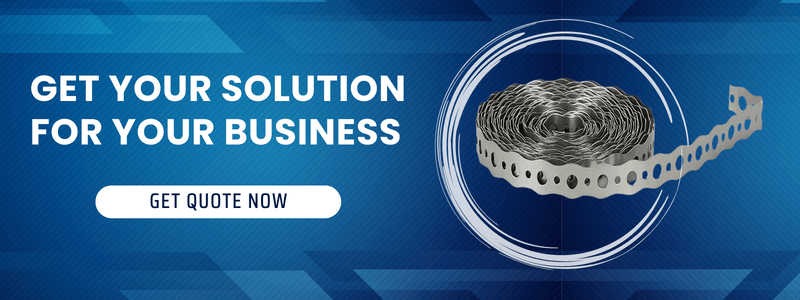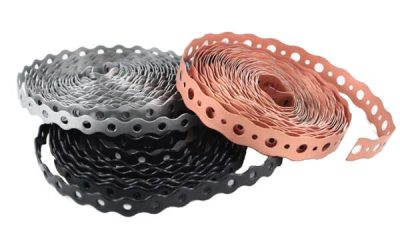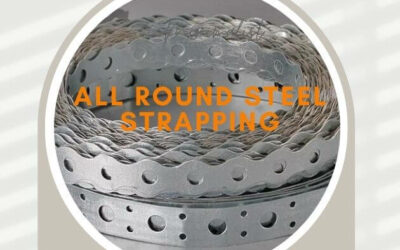Introduction
What are Hanger Straps?
Hanger straps, also known as hanger bands or support clips, are devices used to support pipes, tubes, conduit, ducts, cables, and wire bundles. They wrap around the tube or pipe to provide a tight grip and prevent sagging. Hanger straps are commonly made of galvanized steel, stainless steel, plastic, or rubber. The perforated design allows for adjustability and a custom fit for various tube and pipe sizes.
Importance of Hanger Straps in Tube & Pipe Systems
Hanger straps play a critical role in tube and pipe systems across various industries. They provide secure support and prevent pipes from excessive movement, vibration, and noise. Proper use of hanger straps protects piping from damage and leaks. They evenly distribute the weight load and reduce stress on pipes, joints, and connected equipment. Hanger straps are a cost-effective and versatile solution for supporting horizontal, vertical, and sloped runs of tube and pipe.
Overview of the Article
This comprehensive guide will cover the types, benefits, installation, and applications of hanger straps. You’ll learn about the advantages of different materials like galvanized steel, stainless steel, rubber, and plastic. We’ll provide tips on proper spacing, positioning, and troubleshooting during hanger strap installation. You’ll find useful comparisons between strap types to help choose the right option. We’ll also explore pricing, safety, maintenance, environmental impact, innovations, customer reviews, and FAQs related to hanger straps. Let’s get started.
Types of Hanger Straps
Metal Hanger Straps
Metal is the most common material for hanger straps due to the high strength and durability. The perforated design with holes allows for adjustability.
Stainless Steel Hanger Straps
Stainless steel offers excellent corrosion resistance and can withstand high temperatures. The material is strong but lightweight. Stainless straps have a clean, modern look.
Galvanized Steel Hanger Straps
Galvanized steel is steel coated with zinc to prevent rusting and corrosion. It provides great value for the cost. Galvanized straps are strong and suitable for indoor and outdoor use.
Rubber Hanger Straps
Rubber straps provide vibration dampening and noise reduction. They have good chemical resistance. The flexibility allows rubber straps to conform well to different pipe sizes.
Plastic Hanger Straps
Plastic straps like nylon and polypropylene are lightweight, low-cost options. They are suitable for light duty applications. Plastic has high chemical resistance but low temperature ratings.
Choosing the Right Type for Your Application
Consider the pipe material, load weight, temperature, environment, noise, expected service life and cost when selecting hanger straps. Stainless steel is ideal for high strength and corrosion resistance. Galvanized steel provides an economical solution for protected indoor settings. Rubber excels in dampening noise and vibration. Plastic is suitable for light loads in chemical environments.
Benefits of Using Hanger Straps
Ensuring Pipe and Tube Stability
The tight grip of hanger straps secures pipes and tubes firmly in position. This prevents shaking, swaying or sagging of pipe over time. Hanger straps provide lateral stability and even load distribution.
Preventing Vibrations and Noise
Rubber and plastic hanger straps are effective at minimizing transfer of vibrations from pipes to the support structure. This reduces noise that can be annoying in occupied spaces.
Avoiding Damage to Piping Systems
Sagging pipes are prone to breakage and leaks at joints. Hanger straps transfer the pipe load to the structural supports, preventing overstressing of pipes. This protects piping and connected equipment from damage.
Cost-Effective Solutions
Hanger straps are an economical and easy way to support pipes compared to fabricated supports. They require less installation labor and materials, saving costs.
Installation Guide
Tools and Materials Required
- Hanger straps of selected type and size
- Measuring tape
- Marker or pencil
- Appropriate screws, bolts, concrete inserts
- Power drill and drill bits
- Wrench or screwdriver
- Safety equipment – gloves, glasses, hard hat
Step-by-Step Installation Process
- Measure pipe diameter and length of planned installation runs.
- Select suitable hanger strap size able to fit around pipe with 1-2 inches overlap.
- Mark the desired hanger positions on the pipe. Also mark the support structure like beam, wall or ceiling.
- Drill holes on the support structure aligned with the pipe hanger locations.
- Install concrete inserts, bolts or screws in the support structure holes.
- Use self-tapping screws or bolts to fasten one side of the hanger strap to the support structure.
- Wrap the strap around the pipe and align the holes. Insert screws through the holes to fasten the other side of the strap to the structure.
- Tighten the strap for a snug fit around the pipe. Avoid overtightening.
- Check all connections are secure. Install end caps on cut strap ends for safety.
Proper Spacing and Positioning
- For horizontal pipes, space hangers every 6 feet or less. Vertical pipes may need more frequent supports.
- Position hangers near joints, valves, equipment connections to reduce strain on these areas.
- Allow small gaps between strap and pipe for thermal expansion and contraction.
Safety Precautions
- Use appropriate lifting aids for carrying bundles of straps.
- Wear safety glasses when cutting metal straps. Watch for sharp edges.
- Use caution when working at elevations. Follow fall protection measures.
- Ensure installed hangers can support planned pipe loads.
Rubber Hanger Straps
Advantages and Disadvantages
Rubber hanger straps provide excellent vibration dampening but low thermal resistance. They conform well to various pipe sizes but have lower friction grip compared to metal.
Common Applications
Rubber straps are ideal for supporting pipes subject to vibration like pump pipes or tube near rotating machinery. They are commonly used in combination with metal straps.
Maintenance Tips
Check rubber straps periodically for cracking or deterioration from sunlight, ozone, oils. Replace damaged straps immediately to prevent pipe detachment. Use plastic straps for prolonged UV exposure applications.
Stainless Steel Hanger Straps
Durability and Corrosion Resistance
Stainless steel hanger straps boast excellent strength and durability. The chromium content provides superior corrosion and rust resistance compared to galvanized and carbon steel.
Ideal Environments for Stainless Steel Hanger Straps
Stainless steel straps are ideal for outdoor use and wet, humid or saltwater environments. They perform well in chemical plants, wastewater settings and other corrosive atmospheres.
Comparing with Other Materials
Stainless steel offers better corrosion protection than galvanized or carbon steel. It can handle higher temperatures than plastic or rubber straps. Stainless provides greater durability than nylon straps.
Plastic Hanger Straps
Lightweight and Non-Corrosive
Plastic hanger straps are lightweight, easy to install and suitable for short pipe runs. Materials like nylon and polypropylene have excellent chemical resistance.
Suitable Applications
Plastic straps work well in corrosive environments like chemical plants, plating shops, wastewater treatment and swimming pools. They can support insulated chilled water and refrigerant lines.
Limitations and Considerations
Avoid using plastic straps for hot water pipes or long vertical runs which can cause creep deformation. Use reinforced or metal straps for heavier pipes. Limit ambient temperature to under 150°F for plastic.
Where to Buy Hanger Straps
Leading Suppliers and Manufacturers
Top manufacturers of hanger straps include Anvil, B-Line, Erico, Haydon, Caddy, PHP, MiFab, Simpson Strong-Tie and Wireworks. Buy from reputable industrial supply companies for quality products.
Online vs. Local Stores
Both online and local stores have pros and cons. Online provides convenience and big selection but cannot inspect in person. Local lets you see before buying but has limited inventory.
Price Considerations
Online prices may be cheaper when buying large quantity. But factor in shipping costs. Local stores can offer competitive pricing and no shipping cost for pickup orders.
Hanger Strap Price Comparison
Factors Affecting Pricing
Material, size, thickness, perforation pattern and quantity ordered impact pricing. Stainless steel is the most expensive, followed by galvanized steel, then plastic and rubber.
Price Range for Different Types
- Stainless steel – $2 to $8 per strap
- Galvanized steel – $1 to $3 per strap
- Plastic – $0.5 to $2 per strap
- Rubber – $1 to $5 per strap
Finding Cost-Effective Options
- Buy in bulk quantities for discount pricing
- Galvanized steel offers the best value overall
- Consider thinner-gauge metal straps to save costs
- Plastic is the budget option for light loads
Case Studies
Real-Life Examples of Successful Hanger Strap Applications
At a chemical plant, stainless steel hanger straps supported a new run of pipes carrying corrosive liquids. The straps provided strong structural support and corrosion resistance for a long service life.
In a pharmaceutical facility, rubber hanger straps were installed on water pipes near vibration-sensitive equipment. This eliminated noise and allowed precision equipment to operate properly.
Industry-Specific Solutions
Stainless steel straps meet the demands of coastal wastewater plants with saltwater exposure. In cleanroom manufacturing, plastic straps prevent metal particle contamination. Perforated galvanized straps are standardized in HVAC systems for easy adjustment.
Maintenance and Inspection
Ensuring Longevity of Hanger Straps
Proper installation is key to prevent issues. Regular inspection identifies problems early. Keeping straps clean and dry maximizes life. Replace worn, damaged or corroded straps.
Regular Inspection Practices
Visually inspect straps yearly for rust, splits, broken welds, deformation or fastener issues. Check for loose, shifting or sagging pipes. Confirm straps are sized properly for the pipe.
Troubleshooting Common Issues
Rusting can be controlled with galvanized or stainless steel. Plastic creep can be fixed with metal replacement straps. Noise calls for rubber straps. Use heavier duty straps for deformation.
Safety Guidelines
Compliance with Safety Regulations
Comply with building codes and piping standards from ASME, ASTM regarding hanger spacing, design and installation. Follow OSHA guidelines on fall protection, PPE and safe loading practices.
Ensuring Proper Load Capacity
Select hangers rated for the planned pipe size, content weight and system pressures. Consider safety factors for dynamic loads. Avoid exceeding manufacturer load ratings.
Safety Measures during Installation
Use proper lifting methods, barricade work zones and wear PPE during installation. Follow safety procedures when working at elevations like using fall arrest systems.
Environmental Impact
Eco-Friendly Hanger Strap Options
Plastic straps made of recycled materials have less environmental impact. Galvanized steel contains recycled scrap metal. Stainless steel and rubber straps are durable and reusable.
Recycling and Sustainability
Metal straps can be readily recycled. Seek LEED points by using low VOC coatings. Sourcing straps locally reduces transportation emissions. Minimize construction waste.
Innovations and Future Trends
Advancements in Hanger Strap Technology
Ongoing innovations focus on improved adjustability, vibration dampening, strength-to-weight ratio and faster installation. New perforation patterns and slide buckle designs provide adjustability.
What to Expect in the Future
We’ll see wider adoption of hanger strap sleeves for better vibration control. Straps with quick-connect hanging clips will gain popularity along with pre-assembled hangers. IoT-enabled smart straps will monitor loads.
Customer Reviews and Recommendations
User Experiences and Testimonials
“These rubber hanger straps stopped all the banging noises from our pipes.” – Sarah D., homeowner
“The perforated steel straps allow easy adjustment for different pipe sizes during installation.” – Mark R., contractor
Best Practices Shared by Customers
Customers recommend checking load ratings, allowing thermal expansion, inspecting annually, and using moldable rubber liners to improve grip and reduce abrasion. They suggest avoiding overtightening and using hard nylon in place of soft plastic.
Frequently Asked Questions
Q: How are hanger straps sized?
A: Check your pipe size and add 1-2 inches for the overlap. The banding should fit snugly around the pipe.
Q: Can I reuse old straps when modifying pipe runs?
A: Avoid reusing old straps unless they are in excellent condition. New straps ensure proper structural support.
Q: What is the ideal hanger spacing for steel pipes?
A: For horizontal steel pipe runs, space hangers 6-8 feet apart depending on pipe size and content weight. Closer spacing is needed for plastic pipes.
Q: Should I use rubber grommets under the hanger straps?
A: Rubber grommets help minimize wear and prevents abrasion damage to pipe outer walls. Use them for pipes prone to vibration.
Q: How can I reduce hanger strap corrosion?
A: Choose stainless steel or hot-dip galvanized straps. Use additional coatings/wraps. Maintain proper drainage to keep straps dry.
Conclusion
Recap of Key Takeaways
- Hanger straps are critical components that securely support pipes and tubes
- Various materials like steel, plastic and rubber have different advantages
- Proper installation, spacing and maintenance ensures optimum performance
- Follow safety guidelines and inspect straps regularly
- Advancements continue to improve adjustability, vibration control and ease of use
Emphasizing the Importance of Hanger Straps
Hanger straps provide an economical, easy way to support piping systems and prevent damage. Taking the time to select and install the right hanger straps will pay dividends through enhanced safety, system protection and longevity. This guide covers all the essential factors to consider when incorporating hanger straps into your pipe supports.
Perforated Metal Hanger Straps: Installation, Benefits, and Maintenance
Are you tired of dealing with sagging ductwork or unsupported pipes in your home or commercial building? Proper support is crucial for maintaining the integrity and efficiency of your HVAC and plumbing systems. That's where perforated metal hanger straps come into...
Galvanized Steel Strapping vs Stainless Steel Strapping: A Comprehensive Comparison
Introduction When it comes to securing and bundling materials, steel strapping is a popular choice due to its strength, durability, and versatility. However, not all steel strapping is created equal. Two of the most widely used options are galvanized steel strapping...
How To Install All Round Steel Strapping?
If you're in the construction or plumbing industry, you know that hanging pipes securely is crucial for a successful installation. One of the most reliable methods for supporting pipes is using all round steel strapping, also known as banding. This versatile material...

Justin Wong
Hi, I’m Justin, the technical engineer of Jiangmen Masters. We’ve been running a factory in China that makes metal hanger strap for 16 years now, and the purpose of this article is to share the knowledge related to metal hanger strap from a Chinese supplier’s perspective.




